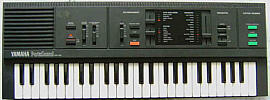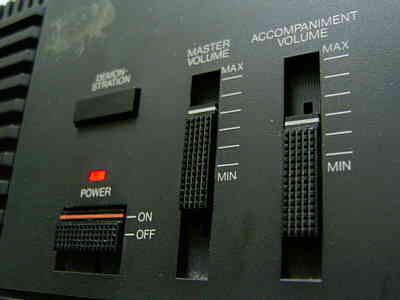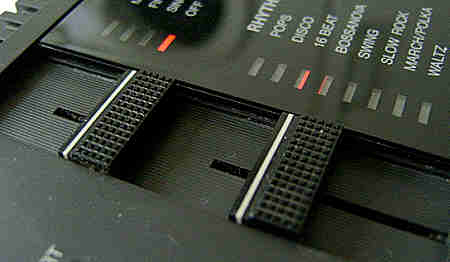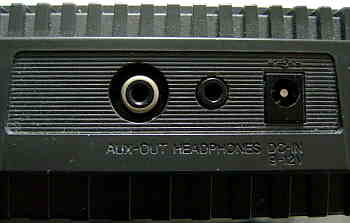 |
 |
This keyboard from 1985 has very simple digital dual waveform timbres those imitate FM and resemble much the bright Yamaha PC-100 sounds, although these ones sound partly even thinner. The most interesting feature is the realtime programmable drum pattern ("custom drummer") with very electronic sounding blip percussion, which in a limited way can be also abused as a tekkno drum computer.
 |
 |
| base, conga, bongo | = sine wave (?) blips |
| snare | = "conga" + shift register noise |
| open cymbal | = unique semi- metallic hissing electronic timbre |
| closed cym. | = dto.' with shorter envelope |
 |
 |
 |
 |
 |
 |
The main voice sound is made from 2 layered static digital waveforms with independent very simple envelopes, those remind to very simple FM sounds. All preset sounds are quite bright and almost harsh, but (unlike e.g. My Music Center) don't sound rough by DAC frequency aliasing noise. The sound style resembles mostly Yamaha PC-100 but is even simpler. The "jazz organ" is a dull Hammond imitation, "flute" is fairly bright, "saxophone" too bright. "oboe" resembles a trumpet, while "trumpet" is too thin and resembles a mosquito with high notes. "violin" is similar, but duller (could be also an accordion). "pipe organ" is way too bright and rapidly fades duller during its slow attack phase; it shall likely imitate a metal pipe organ rank, but sounds too thin and harsh. "piano" is rather a nylon guitar (like with badly made FM instruments), while "electric piano" has a Rhodes timbre. "guitar" is brighter but similar like "piano", while "harpsichord" sounds harsh and way too thin and quiet, which makes high notes almost disappear during accompaniment. "synth" resembles "pipe organ", but is less harsh and has a percussive attack phase. All decaying sounds decay with the same speed. When sustain is switched off, all sounds stop immediately after releasing the key, which permits to play very short blipping notes. The easy moving "orchestra" OBS slide switch can also rapidly change the timbre of held notes, which can be used as a nicely grainy sound effect for live play. (When a decaying sound is selected and the decay phase has begun, the note continues decaying also after switching back to a holding preset sound.) The sound presets itself also contain neither vibrato nor tremolo. The sustain switch adds at position "2" normal sustain (about 1.5s) while at "1" it adds a quieter sustain to simulate distant reverb (nice for pipe organ sounds). The vibrato switch adds a delayed 6Hz vibrato, which is barely audible with decaying sounds since they decay almost completely before the vibrato starts.
The rhythms employ very electronic blip percussion (similar like with cheap FM keyboards, but the cymbals hiss more). The 8 rhythms and their accompaniments are nothing great, but sound rather neutral. Instead of the accompaniment, also a manual bass (monophonic "guitar" sound) can be played. Nice is that the fingered accompaniment accepts any disharmonic note combinations and not only a few establishment chords. Unusual is that the red tempo LED not simply flashes on and off, but indicates the bars by going alternatingly bright, dim, bright, off with 4/4 rhythms and bright, dim, off with 3/4 rhythms. With rhythm off, there is a manual chord mode, those timbre depend on the currently selected preset rhythm (5 different timbres); like with the preset sound slider, with rhythm off also the rhythm slide switch rapidly changes the timbre of held chord notes, which can be used for live play tricks.
![]() The
programmable drum pattern ("custom drummer") is programmed in realtime
in a similar way like with Yamaha PSS-150,
but has less flaws. You have to select one of the preset rhythms as a template
and press the "program start/ end" button which makes the selected rhythm
repeat in a loop. Then you can add additional percussion in realtime
with the rightmost 6 white keyboard keys. (The pattern length depends on
the selected rhythm.) You can even delete individual percussion tracks
by pressing "cancel" simultaneously with the corresponding key. The programming
mode can in a limited way also be abused as a realtime tekkno drum computer
and you can even play keyboard(!) during this on the remaining keys (with
or without accompaniment). The pattern resolution depends on the selected
rhythm and is high enough to get bizarre and complex "tribal" drum loops
out of it. After finishing programming (press "stop" to stop the rhythm),
the user pattern can be played by pressing "play/ stop". You can even change
the accompaniment by simply stopping the rhythm, shifting the "rhythm"
slider to to the rhythm with the intended accompaniment and re- start the
pattern with the "play/ stop" button. The pattern length of the accompaniment
(4/4 or 3/4) automatically adapts to the user pattern length. If you want
to edit the pattern, simply press "program start/ end" while the pattern
is running (otherwise it would be overwritten by the current preset rhythm)
and now you can add percussion or delete tracks.
The
programmable drum pattern ("custom drummer") is programmed in realtime
in a similar way like with Yamaha PSS-150,
but has less flaws. You have to select one of the preset rhythms as a template
and press the "program start/ end" button which makes the selected rhythm
repeat in a loop. Then you can add additional percussion in realtime
with the rightmost 6 white keyboard keys. (The pattern length depends on
the selected rhythm.) You can even delete individual percussion tracks
by pressing "cancel" simultaneously with the corresponding key. The programming
mode can in a limited way also be abused as a realtime tekkno drum computer
and you can even play keyboard(!) during this on the remaining keys (with
or without accompaniment). The pattern resolution depends on the selected
rhythm and is high enough to get bizarre and complex "tribal" drum loops
out of it. After finishing programming (press "stop" to stop the rhythm),
the user pattern can be played by pressing "play/ stop". You can even change
the accompaniment by simply stopping the rhythm, shifting the "rhythm"
slider to to the rhythm with the intended accompaniment and re- start the
pattern with the "play/ stop" button. The pattern length of the accompaniment
(4/4 or 3/4) automatically adapts to the user pattern length. If you want
to edit the pattern, simply press "program start/ end" while the pattern
is running (otherwise it would be overwritten by the current preset rhythm)
and now you can add percussion or delete tracks.
When "play/ stop" is pressed without recording (or after deleting all tracks of the user pattern), the instrument turns rhythm off and switches the rightmost keys into drumpad mode. Interesting is that although sound selection of this instrument is in no way OBS, you can play on the keyboard with rhythm and accompaniment, then program (and delete) in realtime a new user pattern and switch back and forward between the user and the default rhythm pattern all without stopping the accompaniment. (Move the rhythm slider a little to switch from the user pattern to the previous rhythm.)
A simpler variant of the PSS-260 was the Yamaha
PSS-160, which has only squarewave sound and unfortunately lacks
the great custom drummer. A way more versatile keyboard with same sound
IC like PSS-260 was the great
Yamaha MK-100.
| removal of these screws voids warranty... | ||
 |
||
|
|